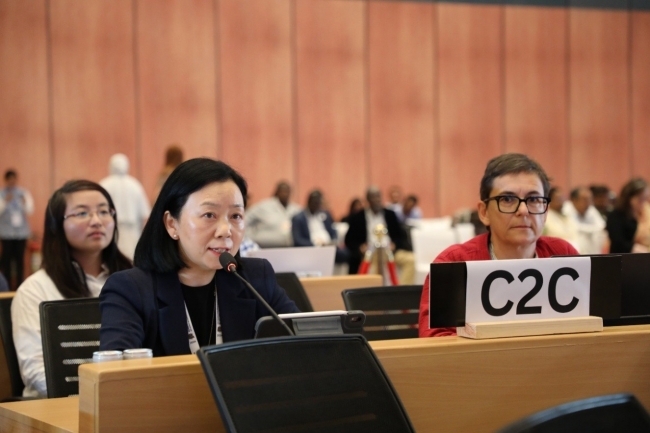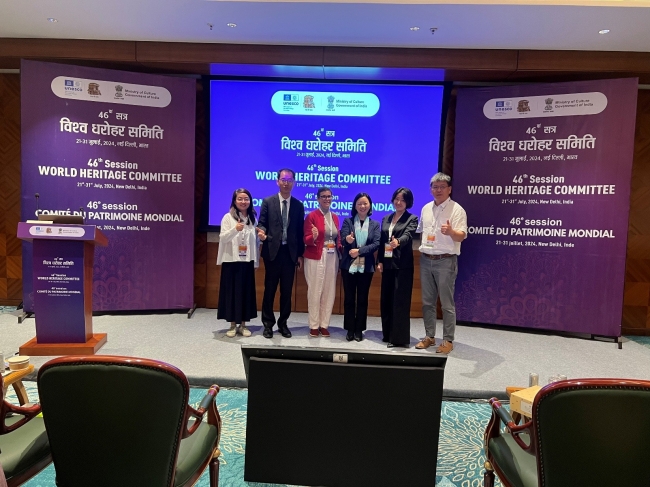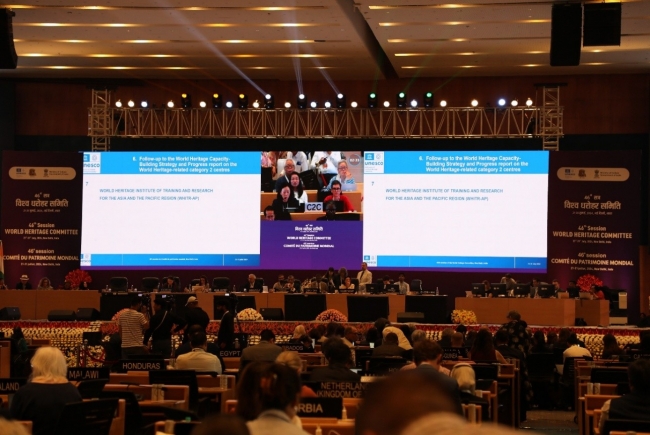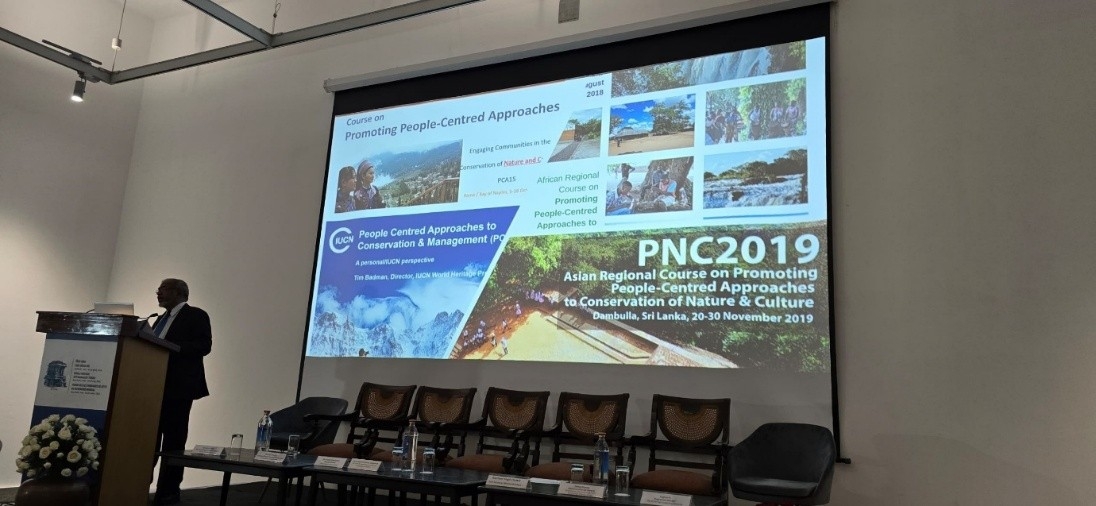| Observation of the 46th Session of the World Heritage Committee | ||
| PublishDate:2024-09-29 Hits:1329 | ||
1. General overview of the 46th session of the World Heritage Committee, New Delhi, 2024Marie-Noël Tournoux
|
| World Heritage in India and New Delhi India ratified the World Heritage Convention (1972) in November 1977 and has on date 43 properties inscribed on the World Heritage List, 35 Cultural, 7 Natural and 1 Mixed. India has already served three terms as a Committee member in 1985-1989, 2001-2007, and 2011-2015, and is now serving its fourth one from 2021 to 2025.
India has taken an active role in the life of the World Heritage List, with the Agra Fort, the Ajanta Caves, Ellora Caves, and the Taj Mahal, inscribed in 1983, being amongst the oldest inscriptions on the List and enriching the List with innovative and complex types of heritage such as the Himalayan Indian Railways inscribe in 1999 which was then one of the earliest large-scale industrial heritage sites. It was later extended in 2005 and 2008 to become a serial site renamed Mountain Railways of India.
The city of New Delhi, the capital city of India has a history going back many centuries, it is home to three World Heritage sites Qutb Minar and its Monuments, Humayun's Tomb and the Red Fort Complex.
|
Opening Ceremony
Key items
From 26 to 29 July, it also examined 28 nomination proposals for inscription on the World Heritage List but inscribed only 26, including 2 major extensions to properties which are considered as new inscriptions. The new inscriptions include 20 cultural properties, 5 natural properties and 1 mixed site, bringing the total number of properties inscribed on the World Heritage List to 1223 in 168 countries. One site ‘Saint Hilarion Monastery/ Tell Umm Amer’ in Palestine’, was both inscribed on the List and on the List in Danger to recognize both the value of the site and its dire need for protection.
It also examined reports on the work of the World Heritage Centre, the UNESCO Category 2 Centres such as WHITRAP, and statutory processes such as the Preliminary Assessment two-phase nomination process. It examined and discussed the management and implementation of the World Heritage Fund -- which is a specificity of the World Heritage Convention compared to other Convention -- and the sustainability of the Convention, with State Parties underlining the paradox of an ever more successful Convention and the limited human and final resources of UNESCO’s World Heritage Centre and the Advisory Bodies as a crucial ongoing challenge. Several States Parties to the Convention were allocated additional funds to finance new conservation work on properties on their territory.
Key trends
Site Managers Forum and the Young Professionals Forum
Dr Gamini Wijesuriya, Special Advisor of WHITRAP, attended the 6th World Heritage Site Managers’ Forum held at Humayun’s Tomb World Heritage Site and Bharat Mandapam International Exhibition and Convention Centre, New Delhi, India from 18 – 25 July 2024. There were 80 participants at the Forum, 40 foreigners and 40 Indians. He delivered the Keynote on Heritage and Communities. In his speech, he stressed that people should be at the heart of the heritage discourse, which we call the people-centred approach promoted by the World Heritage Centre. Engaging communities is about working collectively in a more innovative manner and it is important to improve the quality of life of the communities. By looking ahead, we must envision a future where heritage management is deeply integrated with sustainability, innovation, and community participation.
|
Side events
WHITRAP organized a side event on 23 July from on July 23rd, local time in India, the “Science, Creativity, Empowerment – World Heritage Education Towards the Future” which allowed it to showcase its activities and International Networks it developed in the area of Education.
The WHITRAP team attended and participated in a series of side events, such as “Climate Action Toolkit for World Heritage” organized by ICCROM, the Australian Government, IUCN, ICOMOS and UNESCO, on 23 July, or “Managing Historic Cities in India”, organized by the Madhya Pradesh Tourism Boards and National Institute of Urban Affairs on 24 July, or the “Heritage in Hands: conserving the creativity of Craft Making Sites, organized by ICOMOS and the Chinese National Administration of Cultural Heritage on 25 July to name a few, which were an opportunity to share expertise, promote WHITRAP’s activities and create new ties.
Focus on C2C
In recent years, the role of C2C has become stronger, with more and more solicitation by the World Heritage Committee and the Centre to play a key role in implementing the World Heritage Committee’s key priorities, strategic initiatives and statutory process, in particular in the area of Capacity Building or Periodic Reporting. In the past years, the World Heritage C2C have strengthened their cooperation through joint activities or strategic partnerships.
For example, for the first time in the World Heritage Committee’s agenda, Category 2 Centres were invited in Item 6B to take the floor to share their Progress report on the activities concerning the implementation of the Convention.

Conclusion
For WHITRAP, it was an opportunity to strengthen existing ties with the World Heritage Centre, and its longstanding partners such as ICCROM, ICOMOS and the other C2Cs as well as tying new relationships with practitioners and State Parties which will lead to the development of further activities, through side event and one to one meetings and side-line discussions.
The 46th session of the World Heritage Committee ended on Wednesday 31 July with the ratification of the World Heritage Convention by Nauru, which became the 196 State Party to the Convention, reinforcing its status as one of the most internationally ratified standard-setting instruments in the world and by the Committee announcing that its next session would be held next summer, in Sofia, Bulgaria, under the chairmanship of Professor Nikolay Nenov.

2. Item 7 - State of Conservation
2-1. General trend
The 250 State of Conservation (SOC) reports examined by the Committee highlighted properties face multiple threats and cumulative impacts on their Outstanding Universal Value (OUV). Main threats, rest unchanged year to year, with development pressures such as housing, infrastructure projects, urban expansion, mining, and tourism as the main ones, basically due to the lack of strong governance, respect for heritage values, and robust management systems. The Committee reiterated the need for integration of conservation and management into broader planning, regular assessments, and specialized guidance.
It discussed the challenge of the timely submission of the State of Conservation reports by State Parties by the statutory deadlines, which impacts the smooth dialogue between the State Parties, the Centre and the Advisory Bodies. The backlog of SOC created by rescheduling two Committee sessions is being absorbed but still could be felt.
The Committee as in previous years and as recalled by the Director General, urged State Parties to not consider the World Heritage List in Danger not as a “punishment” but as a tool to support reaching desired states of conservation.
On the issue of Climate Change, which the Committee reassessed as a critical threat, he promoted the Policy Document on Climate Action for World Heritage, focusing on risk assessment, adaptation, mitigation, capacity building and relevant toolkits.
Furthermore, the Committee underlined the critical role of World Heritage properties in biodiversity conservation and emphasized the need to support global biodiversity targets and secure international funding for conservation measures.
2-2. State of Conservation in Asia and Pacific Region at 46 COM
According to the 46 World Heritage Committee (COM), more than half of the World Heritage Sites are faced with inadequate management planning, funding and personnel. In the Asia and Pacific region, six heritage sites are on the List of World Heritage in Danger (7A) and nineteen sites are inscribed on the World Heritage List (7B). The conservation of properties is generally threatened and affected by natural impacts, commercial activities and the lack of a legal framework or management system.
Four of the properties listed on 7A are threatened by natural impacts, including invasive species, climate change, erosion, and flooding. All of properties are threatened by commercial activities, which consist of impacts of tourism, over-exploitation of land and marine resources, and infrastructure construction/ urban development planning. Meanwhile, all of the properties are affected by the lack of a legal framework or management system. This can be due to the prevention of political and organizational processes, political instability, deficient professional personnel and inadequate conversations with WHC.
As for properties from 7B, nine of them are influenced by natural factors, including invasive species (termites), climate change, air and water pollution, natural disasters (monsoon and fire) as well as degradation of seamounts. Sixteen of the properties are affected by commercial activities such as agricultural development, infrastructure construction, tourism, and urban development. eighteen of them have mentioned of inadequate legal framework or management system, which can be resulted from deficient financial support and professional personnel, right issues with indigenous people and local communities, lack of clarity regarding property rights, as well as social changes and population growth. One property has not been previously reported of the factors.
In contrast with the state of conservation of world heritages worldwide, the proportion of properties in the Asia and Pacific region threatened by inadequacy of management planning is higher than that of worldwide. Property conservation is also encountered with other specific issues such as conversations with Indigenous people and requirement of appropriate urban development blueprint.
2-3. IA in Asian and Pacific Region
As stated by 46 COM, thirteen reports of properties in the Asia and Pacific region have mentioned impact assessment, in which Guidance and Toolkit for Impact Assessment is regarded as an important reference for the conservation of world heritage. The majority of the properties are listed on 7B, which is assumed by researchers that IA mainly serves the precaution process.
HIA has been mentioned most compared to EIA and SEA in the 7A & 7B. In general, the majority of the State Parties have not addressed HIAs or used the Guidance for the conservation, as requested by the Committee. Other State Parties, though planning the process of HIA or have implemented HIAs on specific projects, the needs to provide full materials, review and further develop the HIAs. There are properties in difficult conditions. The conservation of Nan Madol (Federated States of Micronesia) has only been addressed with limited progress to its essential aspects, namely statutory protection, adoption of the proposed management system (which was prevented by political and organizational process) and the appointment of a Property Manager. Although the State Party has issued that HIA will be developed, the expansion of tourism resorts has taken place before the preparation of HIA. The conservation of Archaeological Ruins at Moenjodaro (Pakistan)is generally faced with deterioration and damages from the 2022 Monsoon. Expert research, short-term conservation actions, expanded workforce and site training have been addressed to the property. Kathmandu Valley (Nepal) experienced a severe earthquake. Its conservation policies are centred on post-earthquake recovery, improved management and capacity building and training. Concerning the need for a cautious approach to preventive and remedial conservation works, WHC reminds the State Party of the two properties to prepare HIAs along with the Guidance.
As for the conservation of Kakatiya Rudreshwara (Ramappa) Temple (India), ‘Palampet Special Area Development Authority’ was founded to coordinate the overall governance of the property and establish commissions for HIAs. The tourism development plan has been assessed through an HIA, yet there are inadequate reports and materials provided, and a tourism building seems to be located in a sensitive location.
Positive progresses on the preservation of Lumbini (Nepal) can be noted, including its management on disaster risk, visitor, and community and sustainable development. Concerning current projects, such as the halting of the Lumbini World Peace City project, the Committee believes that it emphasizes the need for a HIA of the project proposal along with the Guidance. The absence of submitting HIA and updating HIA guidelines of Nepal is thought to reflect a concerning gap in meeting property conservation standards of OUV. Similar requests have been given to the State Party of Historical Monuments at Makli, Thatta (Pakistan), in which the conservation measures have balanced the sustainability of the property’s living nature and the security works after the Monsoon in 2022.
The preservation of the Old Town of Galle and its Fortifications (Sri Lanka) has been requested for addressing HIA for the port development plan, for the reclamation of land to the south of the port requires an evaluation, and the project for expanding the existing port is recommended to move the infrastructure from its proposed location, concerning the standards of OUV.
The current issues for conserving the Town of Luang Prabang (Lao People's Democratic Republic) made efforts to move forward, revising HIA for the Luang Prabang Hydroelectric Power Project and preparing the Guidance as well. However, the Committee requests that concerning methods for actual operation, the State Party should cooperate with the intervention modalities. Moreover, problems for urban development still exist, since the State Party made no response to the previous requests and HIA needs to be reviewed concerning threatening factors: Major infrastructure and tourism projects.
Both HIA and ESIA are utilized in the current conservation issues of Vat Phou and Associated Ancient Settlements within the Champasak Cultural Landscape (Lao People's Democratic Republic). The mitigation measures on the Champasak Water Supply State Enterprise water supply extension were implemented and reported. There are heritage laws adopted for further provisions of HIAs. The HIA processes are halted by inadequately trained personnel and international experts. The project of Phou Ngoy Dam was assessed by a HIA and a ESIA. WHC welcomes the progress in HIA, requesting that the State Party to change the location for the hydropower project and not start any limiting on-site operations.
A SEA for road development plans was completed in Lorentz National Park (Indonesia). Mitigation measures were implemented for the Habema-Kenyam road, and the dieback of Nothofagus species along the road was monitored. Further implementation needs time and assistance due to several reasons. Though previous assessments include Environmental Impact Assessment (EIA) and Environmental Management Plan (EMP) have been utilized, the Committee concludes that the progress are limited, in contrast with SEAs, concerning the assessment of cumulative impacts of multiple projects and the planning of strategic mitigation measures.
3. Item 8 - World Heritage Nomination
From July 21 to 31, 2024, UNESCO held the 46th session of the World Heritage Committee in New Delhi, India. The main agenda of the meeting was to review 27 sites nominated for inclusion on the World Heritage List and to assess the conservation status of 124 existing sites on the List. After careful deliberation, the conference approved the inscription of 24 new sites on the World Heritage List, along with the acceptance of 2 boundary extension projects.
By the conclusion of this session, the total number of World Heritage sites worldwide reached 1,223, comprising 952 cultural sites, 231 natural sites, and 40 mixed cultural and natural sites. During this conference, China added one new natural heritage site, the Badain Jaran Desert – Towers of Sand and Lakes, and one cultural heritage site, the Beijing Central Axis: A Building Ensemble Exhibiting the Ideal Order of the Chinese Capital. Additionally, a significant modification to the boundaries of Natural property, the Migratory Bird Sanctuaries along the Coast of Yellow Sea-Bohai Gulf of China, was also approved. This brought China’s total number of World Heritage sites to 59, just one fewer than Italy, placing China second globally. However, China continues to lead the world in the number of natural heritage and mixed heritage sites, with 15 natural heritage sites, reaffirming its global leadership in recent years in this category.
Experts and speakers from the World Heritage Centre, advisory bodies, and Committee member states conducted orderly presentations and assessments of the nomination projects submitted this year and exchanged views on the uniqueness of certain sites. Compared to previous conferences, this year’s deliberations seemed to involve less contention and more respect and understanding. Some uniquely qualified new heritage sites garnered widespread attention, reflecting emerging trends in the World Heritage nomination and evaluation process.
Unique New Inscribed Mixed World Heritage
Notably, the criteria (vi) regarding the "association with spiritual beliefs" for this site was proposed through an amendment and was eventually approved after thorough discussion. When assessing the state of conservation of this heritage site, ICOMOS acknowledged its satisfactory condition but also pointed out that factors affecting the nominated property include invasive species, erosion related to the presence of wild animals, potential natural disasters (notably tsunamis), and the impacts of climate change (such as rising sea levels and increasingly frequent and prolonged droughts). This has also raised awareness about how World Heritage sites should respond to the challenges posed by climate change.
Emphasis on the "Africa Priority" Strategy
In addition, the experts discussed how to better reflect regional balance and cultural diversity in the nomination process. In recent years, the number of nominations and approvals from Africa has significantly increased. Of the 24 sites inscribed during this session, five are from Africa, highlighting the success of the "Africa Priority" strategy in the World Heritage field. The number of sites inscribed from Africa has increased from 1-2 per year to five in a single year (4 projects for 2024 and 1 project submitted in 2023), indicating the World Heritage Committee’s efforts to address the previously low number of nominations from this region. This trend helps promote a more balanced and diverse World Heritage List globally.
Furthermore, it is noteworthy that Niokolo-Koba National Park in Senegal was removed from the List of World Heritage in Danger on July 24 following a successful amendment discussion. This decision ended the park’s 17-year status as an "in danger" site. Despite some concerns from advisory bodies regarding the current state of protection and management, the World Heritage Committee’s approval of the amendment reflects recognition and encouragement of the progress made in African World Heritage conservation. This also reaffirms that being placed on the Danger List is not a punishment for the state parties but a means to promote the improvement of World Heritage sites.
Conclusion
4. The "Climate Change" issue at the 46th World Heritage Conference
At the 46th World Heritage Conference held in India, climate change remained one of the topics of frequent discussion. As the global climate crisis intensifies, the threats posed by climate change to World Heritage sites have become increasingly severe. Representatives from countries around the world, experts, and non-governmental organizations engaged in in-depth discussions on this issue during the conference, seeking collaborative solutions.
In recent years, the melting of glaciers, rising sea levels, and the increasing frequency of extreme weather events have threatened many significant World Heritage sites. As stated on the official website of the World Heritage Convention, "Climate change is now the biggest threat to some of the most beautiful places on Earth: World Natural Heritage. From shrinking glaciers to coral bleaching, to more frequent and severe fires and droughts, we have already seen the devastation caused by climate change. The rich biodiversity, diverse and unique ecosystems, and the human communities living in these locations are at risk." (https://whc.unesco.org/en/futurekeepers)
After two years of preparation, the World Heritage Committee adopted the "World Heritage Climate Action Policy Document" in 2023 to address climate change. This document outlines the goals for World Heritage climate action, including climate risk assessment, climate adaptation, climate mitigation, sharing knowledge, capacity building, and raising awareness. It also provides guidelines for implementing these action goals at different levels. To facilitate the implementation of this policy document, the World Heritage Centre and advisory bodies are developing the "World Heritage Climate Action Toolkit." During the side events of this Heritage Conference, information regarding the "climate change" agenda was frequently highlighted. For example, at a side event on July 23, ICCROM, Australia & The Netherlands, IUCN, ICOMOS, and UNESCO gave a presentation on this toolkit, announcing that it will be completed by the end of 2024 under the coordination of the World Heritage Leadership Project. A side event on July 27, titled "Protecting World Heritage in the Face of Climate Change: Exploring the Intersection of SDG 13, Climate Vulnerability, and World Heritage Sites in the Asia-Pacific Region," discussed the intersection of sustainable development and climate change.
Technological innovation also featured prominently in the themes of several side events during the conference. For instance, the side events on "Digital Preservation: Ensuring Cultural Heritage" on July 26 and "World Heritage, Biodiversity, and Climate" on July 27 both addressed how advanced tools such as remote sensing technology, Geographic Information Systems (GIS), and big data analytics can be better utilized to monitor and predict the impacts of climate change on heritage sites and to develop corresponding adaptive measures. During the Q&A sessions, some participants suggested that ecological restoration, vegetation recovery, and the revival of traditional architectural techniques could enhance the resilience of heritage sites and mitigate the adverse effects of climate change.
The discussions at this conference reflect the new challenges faced in the field of global heritage protection and demonstrate the proactive steps taken by the international community to safeguard precious World Heritage sites. It is clear that only through coordinated global efforts can we effectively address the threats posed by climate change to World Heritage sites and ensure that these treasures are preserved for future generations.




